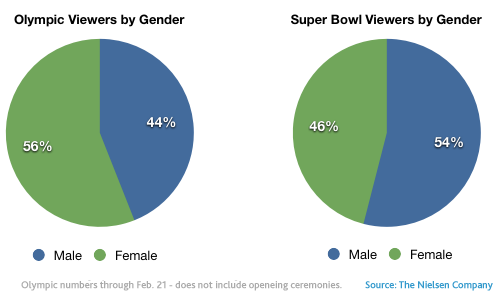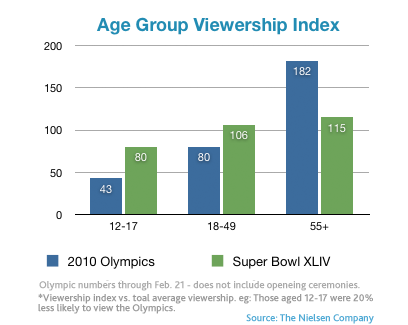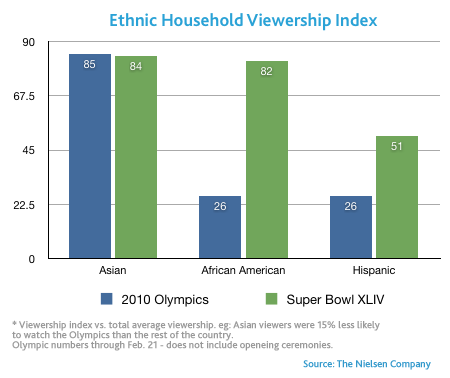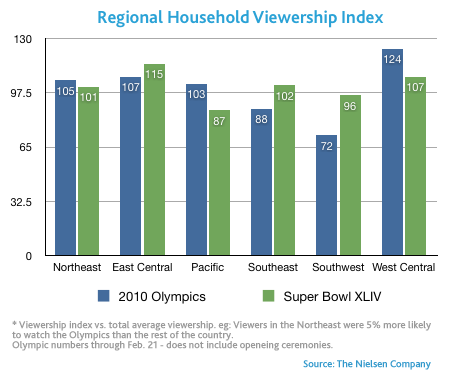In contrast to the Super Bowl, the primetime Winter Olympic TV audience is predominantly female, according to an analysis of primetime Winter Olympic viewership data through February 21. An estimated 56% of Olympic viewers are female, while 44% are male. Super Bowl viewership was almost the exact opposite, with its audience composed of 54% males and 46% females.

A detailed look at who’s watching the 2010 Winter Olympics reveals a wealth of additional insights:
- Olympics ratings are clearly highest among older viewers. Ratings among teenagers are 57% lower than the national average for this year’s primetime Olympics broadcasts. Ratings among the 18-49 group are 20% lower than the national average, while ratings among those 55 and older are 82% higher.
- Olympics viewing among ethnic minorities is considerably lower than it is for the population as a whole. Ratings among Hispanic and African-American viewers are each 74% below the national average. Asian ratings are 15% below the national average
- The Olympics are more widely viewed in the West Central region of the United States than any other part of the country. Ratings in this area are 24% higher than the national average. Viewership is lowest in the Southwest, where ratings are 28% lower than the national average
- Households that view in High Definition are more likely to watch the Games. About 55% of Olympic viewers are in HD-capable/receivable homes. Viewing in these homes are 14% higher. DVR households have similar viewership tendencies. About 41% of Olympic viewers are in DVR homes and have ratings 12% higher than the national average.
Olympics vs. Super Bowl
To lend some context to these demographic insights, Nielsen compared U.S. viewership trends from the Olympics to trends from the Super Bowl played earlier this month. The clearest difference between the ratings performance by gender. Ratings among female Olympics viewers are nine percent higher than the national average, while ratings among male Olympics viewers are nine percent lower. Female ratings were 11% lower than the Super Bowl’s national average, while male ratings were 11% higher.
Much like the Olympics, ratings for the Super Bowl were highest among older viewers, although the difference is not as wide. Ratings among teenagers for the Super Bowl were 20% lower than the national average (compared to the 57% lower ratings for the Olympics). Ratings for the Super Bowl improve in older demographics, where the ratings are 6% higher than the national average in the 18-49 age group and 15% higher among those 55 and over.

The comparison also found that a larger percentage of Super Bowl viewers were African-American, Hispanic, or Asian (23% vs 11% for the Olympics). Ratings within the African-American and Hispanic markets were also higher in the Super Bowl when compared to the national average for each event. Ratings for African-American viewers were 18% lower than the national average for the Super Bowl while Hispanic ratings for the game were 49% lower. Asian ratings for both events were almost identical (16% below average for the Super Bowl vs. 15% below average for the Olympics).

While ratings for the Olympics are highest in the West Central states, Super Bowl ratings were highest among viewers in East Central states. The lowest Super Bowl ratings were in the Pacific territory, which is showing three percent higher ratings for the Olympics compared to the national average.




